Hadrian's Arrival Bowness-on-Solway
When I got to the airport in Dallas, I immediately felt like I needed to go to the B Terminal to meet Jo Anne. 🙁 Alas, she will not be meeting me to fly out today but will meet me in Cheltenham in 10 days.
It is now a day later.
I flew from Dallas, TX to London, UK. From the London airport, I took the Heathrow Express train to Paddington Station, then hopped on the Tube using the Circle Line to Euston Square. It was a five-minute walk to Euston Station, where I was able to catch the Avanti West Coast Railway to Carlisle, just under 4 hours on that train. From Carlisle I caught the bus to Bowness-on-Solway, about 30 minutes, but only runs 3 times daily so timing was critical on all the above connections. Fortunately, I bought a Britrail Pass so I didn't have to wait in line to purchase tickets; just hop on the correct train and go. Well worth it as the cost for the pass was less than the cost of one of my scheduled trains.
Heathrow Express to Paddington
On the Heathrow Express
Unfortunately, the flight was 30 minutes late arriving in London and I knew any delay would result in me missing the earlier train to Carlisle. No worries, there was another train leaving an hour later. The only thing about the later train is it causes a 4 hour layover in Carlisle. However, my bag came off quickly, I found my way to the Heathrow Express without much ado, wandered around Paddington Station for a bit before asking someone how to get to the Tube (Subway), arrived Euston Station and found the correct platform for the early train that said “boarding”. When I went through the turnstile the lady said I was too late, it was closing, but one of the porters said come on. I walked onto the train at 8:30, the exact time of departure. What a wondrous surprise and blessing.
“See it, say it, sorted” is the phrase of the day, relating to anything unusual or suspicious you might see in any of the stations or trains.
Oddly enough I ended up in the First Class car where they treat you quite nice. Kept bringing me sparkling water and offered a breakfast and lunch menu. I refrained thinking it was for sale but found out it was included. Everything I saw looked delicious and then the chef came out making me wish I had ordered something. It was definitely not the prepackaged meals served on the airplane.
More train pics.
Jo Anne, we went through the Lake District. I’m actually staying just north of where we started the coast to coast at St. Bees.
Do these fells look familiar?
Yes ma'am, those mountains in the background are the ones we bouldered over less than two years ago.The reason there are so many of these photos is Jo Anne said I didn't get to pick and choose what to post. She wants to see them all.
Carlisle Train station
up and over the tracks I goCarlisle Bus Station. It was raining when I got to Carlisle and the wind was blowing and cold. People were all bundled up complaining that it was winter again. Fortunately I had my raincoat in my backpack so it was easily accessible. The walk from the train station to the bus station was about a mile over very rough cobble stone streets, dragging a suitcase that got heavier by the minute.
And the bus which was supposed to take 30 minutes to get from Carlisle to Bowness-on-Solway, took an hour. I'm not sure why because the driver was driving like a maniac. I met two ladies on the bus who are starting the Hadrian's Wall walk tomorrow too.
Kim these two photos are for you. It’s the McVitie's factory. I could almost smell the chocolate covered digestives. 😀
St. Michael's Church
The 12th-century parish church of St Michael's is built atop the granary of the Roman fort and is partly built with stones from the fort, as are a number of other local buildings. In 1626 raiders from Scotland stole a pair of bells from St Michael's, only to lose them while making their way back across the Solway Firth. The villagers retaliated by raiding north across the firth and making off with bells from churches of Dornock and Middlebie.
A tradition arose that each time a new vicar of Annan takes office, the vicar must petition Bowness for the return of the bells. Yet here they sit, in the church porch, as they have done for almost 4 centuries. The church was not open today so I couldn't get a picture of the bells.
Since it was also cold and rainy in Bowness-on-Solway when I arrived and I couldn't check-in to my room until 3:30, and I hadn't eaten anything much since I left home, I decided it would be a good time to go to the pub and grab some lunch/dinner.
It was a very good idea. The soup of the day was butternut squash. Just what I needed on a cold rainy day. Of course it came with 'chips'. Delicious! After I finished my lunch and was going to walk about town to kill some more time, it came a gully-washer.
I decided it might be better to just sit awhile longer in the pub and have a spot of tea. There was a group of 6 old women (about my age 😆) also starting the walk tomorrow. Listening to them made me very happy that I am walking solo. There were also two men who came in that had just finished the walk, going east to west.
When the sun popped out again I walked down the road to my inn. I'm staying at Wallsend B&B in Bowness-on-Solway, located near the church at the beginning/end of Hadrian's Wall Path. It's a lovely B&B and perfect location. It's just a short walk to Kings Arms Pub for dinner. I think it's the only place to eat in Bowness. This is the lounge area. As I sit here in the room writing this I can hear the church bells at St. Michaels pealing loud and sweet.
My packet from Mac's Adventure was waiting for me at the inn. Hopefully I can stay awake long enough to study tomorrow's map.
There were also some chocolate mallows in the tea tray. Not for me, but a nice touch.
These two photos are the views from my room.
Since the rain had stopped, I figured it was a good time to scope out the start of tomorrow's walk and see what there is to see in Bowness-on-Solway.
I thought this tiny window in the huge wall of stone was so interesting.
the obscure path that leads to the start of the Hadrian's Wall Path
While I was down here, 4 women came across the start/finish. Their exuberance over finishing was encouraging. I took their photos at the finish.
The pebbles are the same colors as the ones we picked up just south of here at St. Bees but are much larger. Real ankle turners if you're not careful.
The tide is out so far that the best I can do is put my hand in the water. It's just too muddy and far to walk out to it. High tide is at midnight tonight and noon tomorrow so I guess I will miss dipping my feet in.
Bowness-on-Solway is the closest village to the western end of Hadrian's Wall, and the site of a Roman army camp. The name comes from old Norse words for a rounded headland. The Hadrian's Wall National Trail begins (or ends here as most people walk this trail from east to west), but leave it to me to be different.
When the Romans built Hadrian's Wall in AD 122 they established a fort at its western terminus called Maia. This was the second-largest fort on the course of the Wall, and just outside the south entrance to the fort a small vicus, or civilian settlement, grew up. It was this settlement that grew to become the village of Bowness.
lovely garden
salvia cistus
ground elder
rhododendron
red valerian
wild rose
old fashioned weigela
elderberry
dancing chicken
The headland at Bowness on Solway once led to a crossing point over the Solway Firth into Scotland, known as a ‘wath’. That route may have been one taken by early Christian missionaries such as Saint Mungo and Saint Ninian, who sailed between the two countries.
In 1869, a new crossing opened – the Solway Junction Railway. This mile-long viaduct across the Solway Firth was designed to shorten the journey times from West Cumbria to Lanarkshire, Scotland for the transportation of haematite (a reddish black mineral – Greek [blood-like]) from the Cumbrian mines to the Scottish iron works. But the project wasn’t very successful. The drainage of the moss on the English side caused terrific problems due to the fact the ground was so spongy, everything sank until the bogs were drained. Then in the winter of 1880, ice floes covered the Solway Firth and 45 of the 193 piers which carried the line across to Scotland collapsed. The line reopened in 1885, ran until 1921, then the viaduct was dismantled in 1934. Looking to the west from the village you can see the embankment (footings) sticking out into the Firth, and to the north its partner on the Scottish side. They are all that remains of this engineering marvel.
One ostensible reason for the railway viaduct being destroyed was that thirsty Scots would cross on Sunday in search of a drink, to take advantage of England's more liberal alcohol laws. Somewhat the worse for wear, they would make their unsteady way home after a drinking bout and more than one was lost in a fall from the viaduct. Truth or fiction?
A common misconception is that Hadrian's Wall is some kind of boundary with England and Scotland. Far from it. The structure was built long before the countries were born. It was simply as far as Roman Britannia went North. Today the whole of it is very much within England, with its western end nearly at the border of Scotland (0.6 mile) and in the east 70 miles south of what is now Scotland. I would gladly have walked over to step into Scotland while in Bowness but the 6/10ths of a mile is across the Solway Firth with no mode of transportation available other than taking 2 buses all the way around for a couple of hours. I've had enough of trains, planes and buses today to not give that a second thought.
Stretching away from Bowness is a large area of sand dunes, salt marshes (watch out for adders), and shingle beds where a wide variety of seabirds gather. The wildlife makes Bowness a good center for bird-watchers. There are several viewpoints and lay-bys handy for watching the local avian life along the shore. Commonly spotted species include dunlin, curlew, godwit, redshank, and oystercatchers.
Today's stats weren't bad considering I was on planes, trains, and buses most of the day.
Steps - 12,336
Miles - 5.4
Floors - 9
Thought for the day: Spiritual self-discipline consists in girding your mind for action. A Roman soldier, when he went into battle, would take the four corners of his loose-fitting tunic and tuck them into his belt. He would pull in all the loose ends so that they wouldn't hinder his engagement in combat. That's precisely the idea of self-discipline. Pull in the loose ends of your thinking; gird up your mind. "Therefore, preparing (girding) your minds for action, and being sober-minded, set your hope fully on the grace that will be brought to you at the revelation of Jesus Christ." 1 Peter 1:13









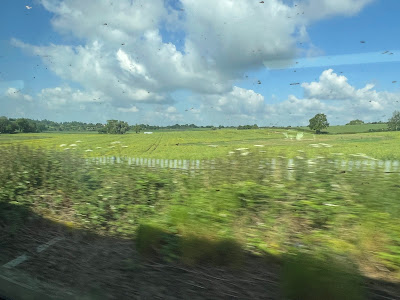

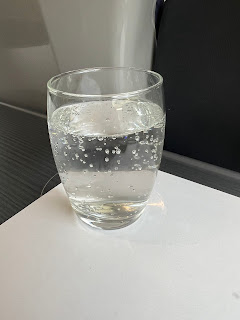








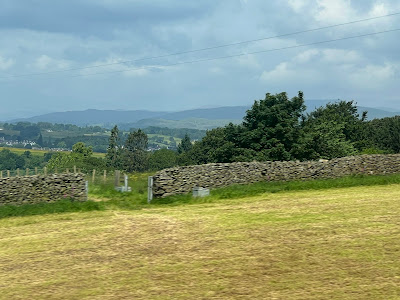




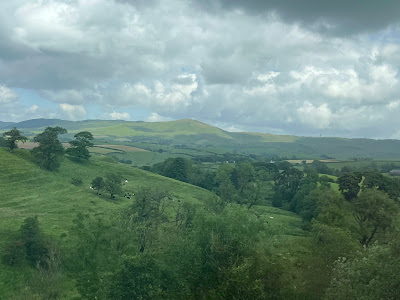







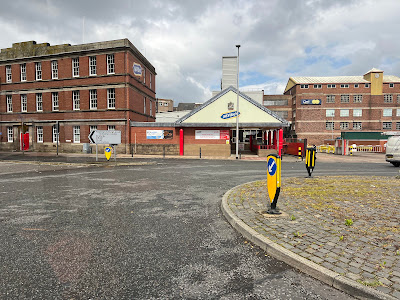













































I’m sure you know how much I wish I had been standing in terminal B waiting on you. 😔 I’m super glad all your connections worked out so well. Of course those fells look familiar 🤪 Thank you for all the pics. Love them all. Wow! Those plant/flower pictures are so vibrant. Just beautiful. I sure am hoping and praying you have clear warm weather for your journey. You had butternut soup? It’s okay, go ahead and rub it in 😂 Maybe I’ll find my own bowl in The Cotswolds. And of course no day for you is complete without a cuppa. So glad you made it safely. Happy walking! Love you, J
ReplyDeleteCarol, I am so glad that you arrived safely. Get some rest and have a fun safe walk. I do hope you have nice weather.
ReplyDeleteVicki
Love that you are safely at your destination. Such an adventure! Karen
ReplyDeleteCarol I enjoy reading about your adventures!! Sheri
ReplyDeleteSo glad you arrived safe and sound. As always, love all the photos and information you share. Such a wee little red window in the rock wall! Praying for your safety and rest. Liz
ReplyDeleteYeah! You made it, so many planes, trains, and busses! I love the brick wall with the red window and red door. Please get lots of door pictures Carol,. Enjoy your journey - Cathie
ReplyDeleteWell, you love your history, hiking and we love your blogs! Have fun and I really like the landscape photos. Is Cowboy joining you somewhere?
ReplyDelete